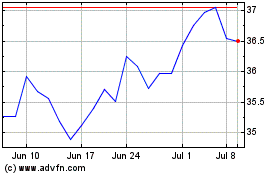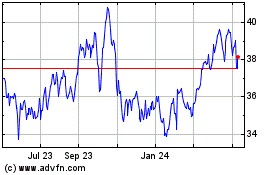By Christopher M. Matthews and Sarah McFarlane
The big international oil companies are reporting one of their
worst annual performances in decades and signaling that the
pandemic could continue to challenge their businesses in 2021.
Exxon Mobil Corp. and BP PLC on Tuesday disclosed annual losses
of $22 billion and $18.1 billion respectively, following Chevron
Corp., which on Friday reported a $5.5 billion loss for 2020.
Exxon posted its fourth consecutive quarterly loss for the first
time in modern history, driven by a more than $19 billion
write-down. Excluding the impairment, Exxon turned a quarterly
profit of $110 million.
BP reported a replacement cost profit -- a metric similar to the
net income figure that U.S. oil companies report -- of $825 million
for the three months ended Dec. 31, from a loss of $4 million in
the year-earlier period.
Covid-19 has sapped demand for oil, hitting prices and prompting
the world's biggest energy companies to slash spending, cut jobs
and write down the value of their assets. Amid the crisis, Exxon
and Chevron discussed a merger of the U.S. oil giants last year,
according to people familiar with the matter, although the talks
didn't progress.
"The past year presented the most challenging market conditions
Exxon Mobil has ever experienced," said Chief Executive Darren W.
Woods.
Exxon remains under pressure from a pair of activist investors.
One of them, Engine No. 1 LLC, nominated four directors to Exxon's
board last week and called for it to make strategic changes to its
business plan. On Tuesday, Exxon announced it had elected a new
independent director to its board and is continuing discussions
with other director candidates.
Engine No. 1 said the changes were insufficient.
"A board that has underperformed this dramatically and defied
shareholder sentiment for this long has not earned the right to
choose its own new members or pack itself in the face of calls for
change," Engine No. 1 said in a statement. "Exxon Mobil
shareholders deserve a board that works proactively to create
long-term value, not defensively in the face of deteriorating
returns and the threat of losing their seats."
BP said Tuesday that Covid-19 restrictions would continue to sap
demand early in 2021 and that the pandemic might have an enduring
impact on the global economy, with the potential for weaker demand
for energy for a sustained period.
Still, Chief Executive Bernard Looney said the company expects
demand to stabilize this year, although the speed and degree of the
recovery is uncertain.
"It's all dependent on vaccine rollouts, vaccine efficacy and
OPEC compliance," Mr. Looney said. Unlike its U.S. counterparts,
Mr. Looney said that BP hadn't spoken to any of its peers about
mergers, and that it was focused on executing its strategy to pivot
toward low-carbon energy.
BP's shares traded 3.1% lower in London on Tuesday as the
results came in below analysts' expectations. Exxon was slightly up
premarket Tuesday following its results.
Other oil companies are also feeling the strain. Royal Dutch
Shell PLC reports Thursday and has telegraphed it will take a large
write-down.
The pandemic has already triggered the largest revision of the
value of oil-and-gas assets in at least a decade, as companies sour
on costly projects amid the prospect of low prices for years.
Exxon's more than $19 billion write-down, primarily related to U.S.
shale gas assets, is among the largest ever taken in the
industry.
The Irving, Texas-based company cut nearly $12 billion from its
2020 capital expenditures and $8 billion from operating expenses in
response to the pandemic and said Tuesday that it will trim
operational spending by another $3 billion by 2023.
Exxon plans to spend as much $25 billion a year on capital
expenditures through 2025, but said Tuesday that if Brent crude oil
prices fall below $45 per barrel, the company could cut spending
further. The company said it expects to cover its dividend, which
costs it about $15 billion annually, from its cash flow in 2021,
assuming Brent is $50 per barrel. It was trading around $56
Tuesday.
Activist investor Engine No.1 has argued Exxon should focus more
on investments in clean energy while cutting costs elsewhere to
preserve its dividend. However, Exxon and rival Chevron haven't set
out plans to invest substantially in renewables, instead choosing
to double down on oil and gas. Both companies have argued that the
world will need vast amounts of fossil fuels for decades to come,
and that they can capitalize on current underinvestment in oil
production.
On Monday, Exxon said it would form a business unit focusing
exclusively on technologies to reduce carbon emissions, investing
about $3 billion through 2025, primarily on carbon-capture
projects, which gather carbon emissions from industrial processes,
or directly from the air, and deposit them underground.
BP has suggested demand for fossil fuels might never fully
recover and that the pandemic could accelerate the pace of
transition to a lower-carbon economy.
Under Mr. Looney, BP has embarked on a plan to reduce its
dependence on oil and gas, while increasing investments in
low-carbon energy like wind and solar power.
French energy giant Total SE has also outlined plans to build up
its renewables business, while Shell has signaled its intention to
set out a similar path later this month.
"An unprecedented demand collapse has forced the hand of Big Oil
to right-size their dividends and capital frames; meanwhile plans
for energy transition have been accelerated," said Christyan Malek,
an analyst at JPMorgan.
To bolster its finances, BP has been selling assets to reduce
debt. The company said it was now more than halfway to its target
of $25 billion of asset sales by 2025, helped Monday by the sale of
a 20% stake in a gas development in Oman. BP aims to lower its debt
to $35 billion by the first quarter of next year, down from $39
billion at the end of 2020.
Rebecca Fitz, a senior director at Boston Consulting Group, said
she thinks both the European and American strategies can work, but
both must deliver better returns and produce less carbon to be
palatable to investors.
"When you have less capital, choices around how you allocate
that capital are more stark," Ms. Fitz said.
Allison Prang contributed to this article.
Write to Christopher M. Matthews at christopher.matthews@wsj.com
and Sarah McFarlane at sarah.mcfarlane@wsj.com
(END) Dow Jones Newswires
February 02, 2021 09:56 ET (14:56 GMT)
Copyright (c) 2021 Dow Jones & Company, Inc.
BP (NYSE:BP)
Historical Stock Chart
From Mar 2024 to Apr 2024

BP (NYSE:BP)
Historical Stock Chart
From Apr 2023 to Apr 2024
